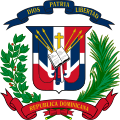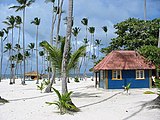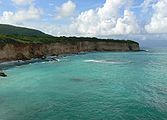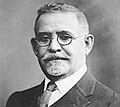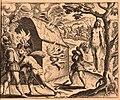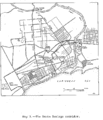Portal:Dominican Republic
Introduction
The Dominican Republic is a country on the island of Hispaniola in the Greater Antilles archipelago of the Caribbean Sea, bordered by the Atlantic Ocean to the north. It occupies the eastern five-eighths of the island, which it shares with Haiti, making Hispaniola one of only two Caribbean islands, along with Saint Martin, that is shared by two sovereign states. It is the second-largest nation in the Antilles by area (after Cuba) at 48,671 square kilometers (18,792 sq mi), and second-largest by population, with approximately 11.4 million people in 2024, of whom approximately 3.6 million live in the metropolitan area of Santo Domingo, the capital city. The Dominican people declared independence from Spain in November 1821. The colony of Santo Domingo was regionally divided with many rival and competing provincial leaders during the 1800s. Dominicans were often at war fighting against the French, Haitians, Spanish, or amongst themselves, resulting in a society heavily influenced by military strongmen. Santo Domingo attained independence as the Dominican Republic in 1844 when Dominican nationalists led an insurrection against the Haitians. Over the next decades, the Dominican Republic experienced several civil wars, battles against Haiti, and a brief return to Spanish colonial status, before permanently ousting the Spanish during the Dominican War of Restoration of 1863–1865. The U.S. occupied the Dominican Republic (1916–1924) due to threats of defaulting on foreign debts; a subsequent calm and prosperous six-year period under Horacio Vásquez followed. From 1930 the dictatorship of Rafael Leónidas Trujillo ruled until his assassination in 1961. Juan Bosch was elected president in 1962 but was deposed in a military coup in 1963. A civil war in 1965, the country's last, was ended by U.S. military intervention and was followed by the authoritarian rule of Joaquín Balaguer (1966–1978 and 1986–1996). Since 1978, the Dominican Republic has moved toward representative democracy. The Dominican Republic has the largest economy (according to the U.S. State Department and the World Bank) in the Caribbean and Central American region and is the seventh-largest economy in Latin America. Over the last 25 years, the Dominican Republic has had the fastest-growing economy in the Western Hemisphere – with an average real GDP growth rate of 5.3% between 1992 and 2018. GDP growth in 2014 and 2015 reached 7.3 and 7.0%, respectively, the highest in the Western Hemisphere. Recent growth has been driven by construction, manufacturing, tourism, and mining. The country is the site of the third largest (in terms of production) gold mine in the world, the Pueblo Viejo mine. (Full article...) Selected article - General images -The following are images from various Dominican Republic-related articles on Wikipedia.
Selected picture -A view of the coastline at Monte Cristi Province
Selected biography -Oscar Francisco Taveras (June 19, 1992 – October 26, 2014) was a Dominican–Canadian professional baseball outfielder who played one season for the St. Louis Cardinals of Major League Baseball (MLB). Known as "El Fenómeno" (Spanish for "The Phenomenon") in the Dominican Republic, the Cardinals signed him at age 16 in 2008 as an international amateur free agent and he made his MLB debut in 2014. Over six minor league seasons, he batted .321 with a .519 slugging percentage. He played all three outfield positions while spending most of the time in center field. With prodigious batting skills, Taveras was a consensus top-five minor league prospect in 2013 and 2014. He elicited comparisons to former MLB outfielder and fellow Dominican Vladimir Guerrero—with a powerful and smooth, balanced stroke, Taveras successfully hit pitches well outside of the strike zone. Also similar to Guerrero, he possessed a strong and accurate throwing arm. The outfielder was the recipient of a litany of awards and won batting titles in two minor leagues, including hitting .386 for the Midwest League title in 2011. The next year, he won the Texas League batting title and was the Texas League Player of the Year and Cardinals organization Player of the Year. (Full article...)Related portalsWikiProjects
Things to do
Associated WikimediaThe following Wikimedia Foundation sister projects provide more on this subject:
SourcesDiscover Wikipedia using portals | |||||||||||||||||||||||||

